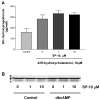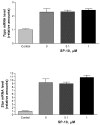Identification of a benzamide derivative that inhibits stress-induced adrenal corticosteroid synthesis
- PMID: 19783933
- PMCID: PMC6254727
- DOI: 10.3390/molecules14093392
Identification of a benzamide derivative that inhibits stress-induced adrenal corticosteroid synthesis
Abstract
Elevated serum glucocorticoid levels contribute to the progression of many diseases, including depression, Alzheimer's disease, hypertension, and acquired immunodeficiency syndrome. Here we show that the benzamide derivative N-[2-(4-cyclopropanecarbonyl-3-methyl-piperazin-1-yl)-1-(tert-butyl-1H-indol-3-yl-methyl)-2-oxo-ethyl]-4-nitrobenzamide (SP-10) inhibits dibutyryl cyclic AMP (dbcAMP)-induced corticosteroid synthesis in a dose-dependent manner in Y-1 adrenal cortical mouse tumor cells, without affecting basal steroid synthesis and reduced stress-induced corticosterone increases in rats without affecting the physiological levels of the steroid in blood. SP-10 did not affect cholesterol transport and metabolism by the mitochondria but was unexpectedly found to increase 3-hydroxy-3-methylglutaryl-coenzyme A, low density lipoprotein receptor, and scavenger receptor class B type I (SR-BI) expression. However, it also markedly reduced dbcAMP-induced NBD-cholesterol uptake, suggesting that this is a compensatory mechanism aimed at maintaining cholesterol levels. SP-10 also induced a redistribution of filamentous (F-) and monomeric (G-) actin, leading to decreased actin levels in the submembrane cytoskeleton suggesting that SP-10-induced changes in actin distribution might prevent the formation of microvilli-cellular structures required for SRBI-mediated cholesterol uptake in adrenal cells.
Figures










Similar articles
-
Inhibition of adrenal cortical steroid formation by procaine is mediated by reduction of the cAMP-induced 3-hydroxy-3-methylglutaryl-coenzyme A reductase messenger ribonucleic acid levels.J Pharmacol Exp Ther. 2003 Dec;307(3):1148-57. doi: 10.1124/jpet.103.055178. Epub 2003 Oct 14. J Pharmacol Exp Ther. 2003. PMID: 14560037
-
Absence of HDL cholesteryl ester uptake in mice via SR-BI impairs an adequate adrenal glucocorticoid-mediated stress response to fasting.J Lipid Res. 2008 Apr;49(4):738-45. doi: 10.1194/jlr.M700475-JLR200. Epub 2008 Jan 19. J Lipid Res. 2008. PMID: 18204096
-
Scavenger receptor BI (SR-BI) is up-regulated in adrenal gland in apolipoprotein A-I and hepatic lipase knock-out mice as a response to depletion of cholesterol stores. In vivo evidence that SR-BI is a functional high density lipoprotein receptor under feedback control.J Biol Chem. 1996 Aug 30;271(35):21001-4. doi: 10.1074/jbc.271.35.21001. J Biol Chem. 1996. PMID: 8798380
-
Roles of scavenger receptor BI and APO A-I in selective uptake of HDL cholesterol by adrenal cells.Endocr Res. 2000 Nov;26(4):639-51. doi: 10.3109/07435800009048584. Endocr Res. 2000. PMID: 11196441 Review.
-
SR-BI and cholesterol uptake into steroidogenic cells.Trends Endocrinol Metab. 2003 Dec;14(10):467-72. doi: 10.1016/j.tem.2003.10.002. Trends Endocrinol Metab. 2003. PMID: 14643062 Review.
Cited by
-
4-Bromo-N-phenyl-benzamide.Acta Crystallogr Sect E Struct Rep Online. 2012 Apr 1;68(Pt 4):o1269-70. doi: 10.1107/S1600536812013487. Epub 2012 Mar 31. Acta Crystallogr Sect E Struct Rep Online. 2012. PMID: 22606197 Free PMC article.
References
-
- Kiraly S.J., Ancill R.J., Dimitrova G. The relationship of endogenous cortisol to psychiatric disorder: a review. Can. J. Psychiatry. 1997;42:415–420. - PubMed
Publication types
MeSH terms
Substances
LinkOut - more resources
Full Text Sources
Medical
Research Materials

